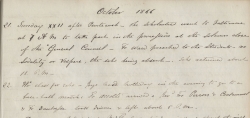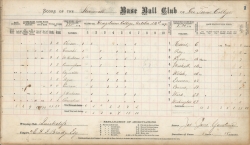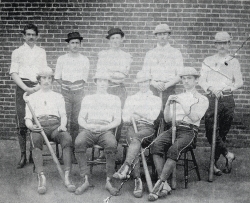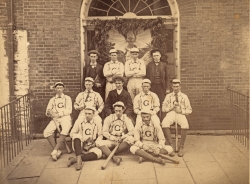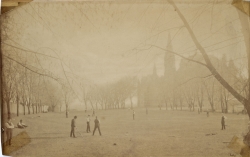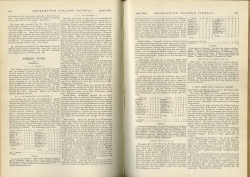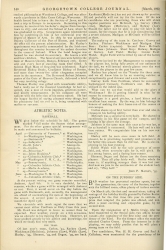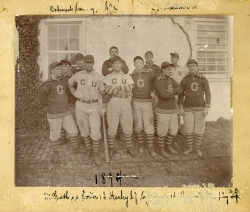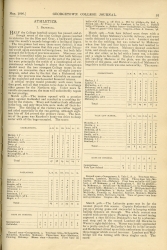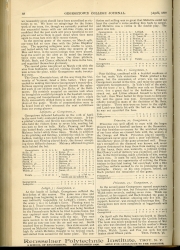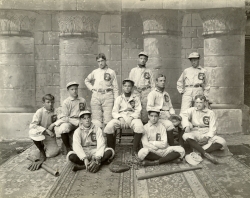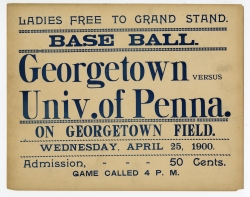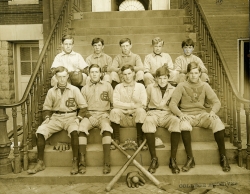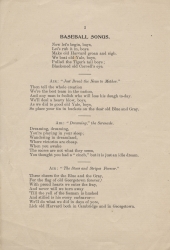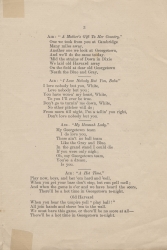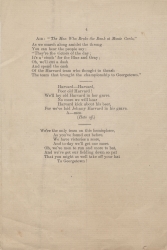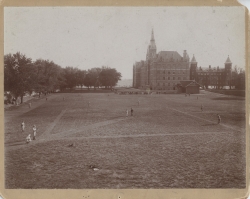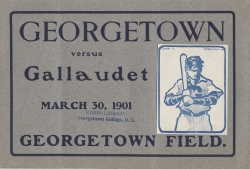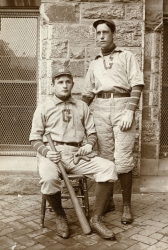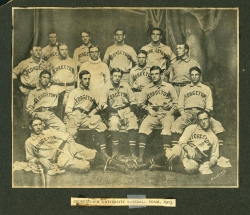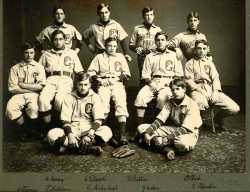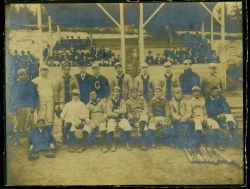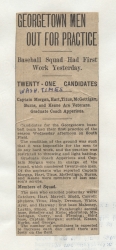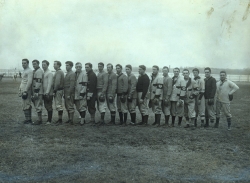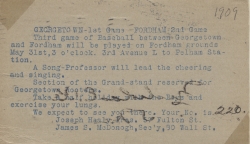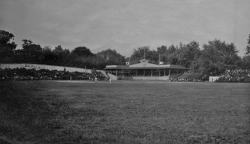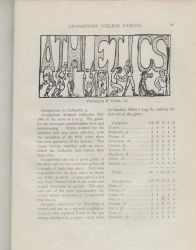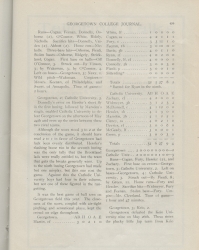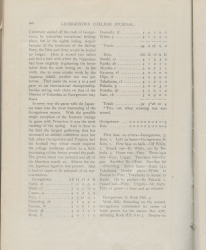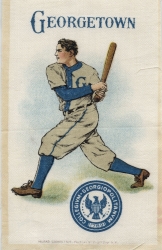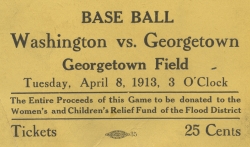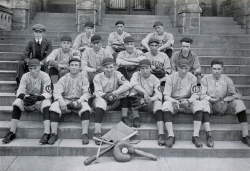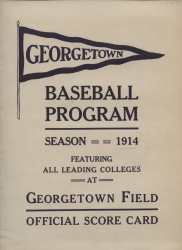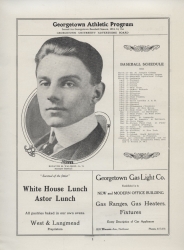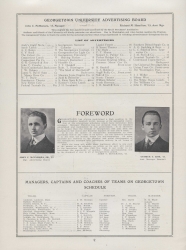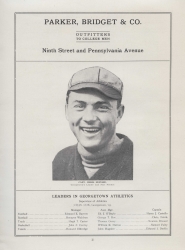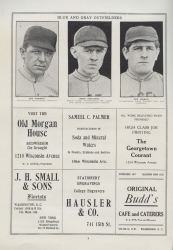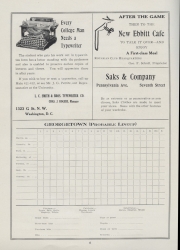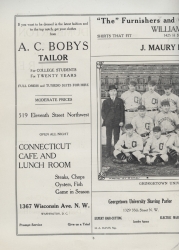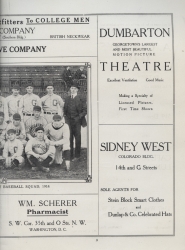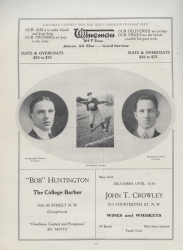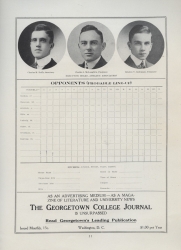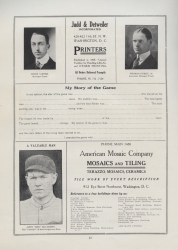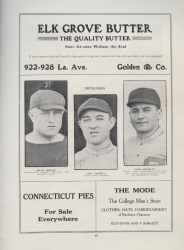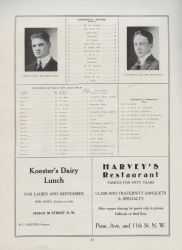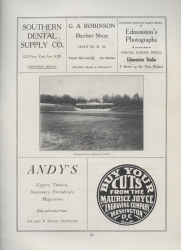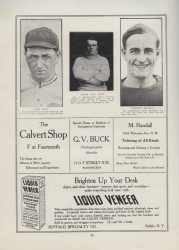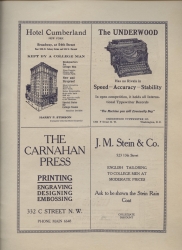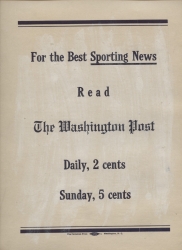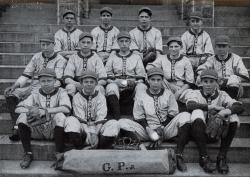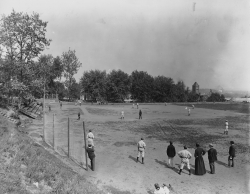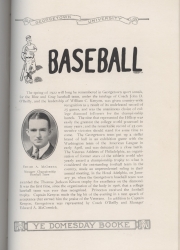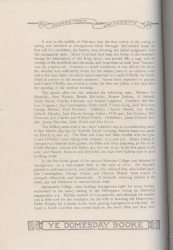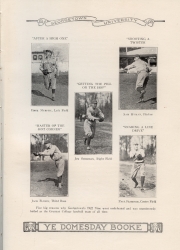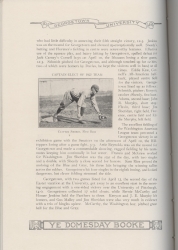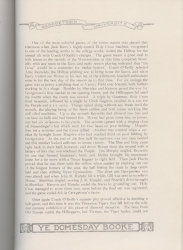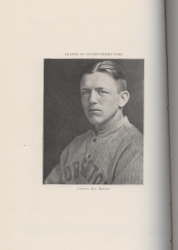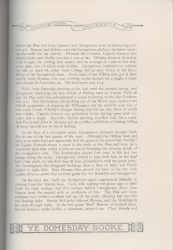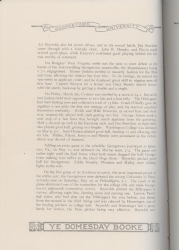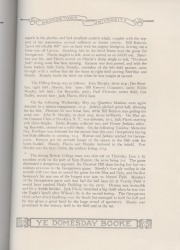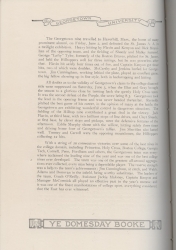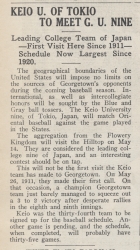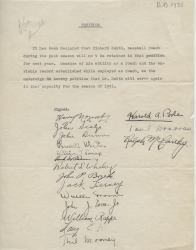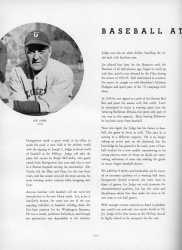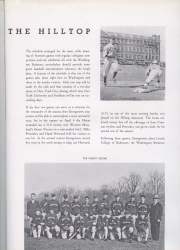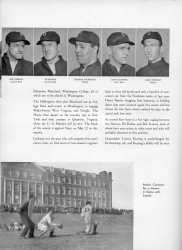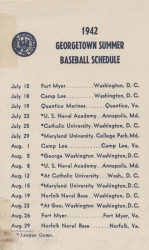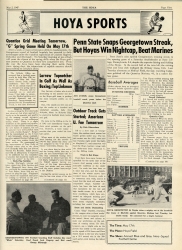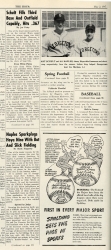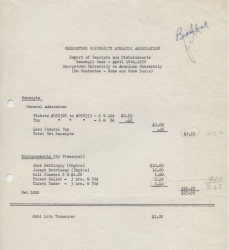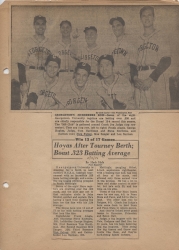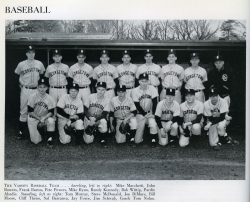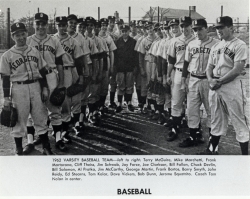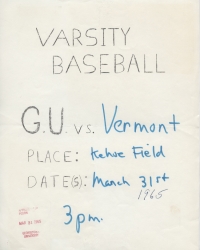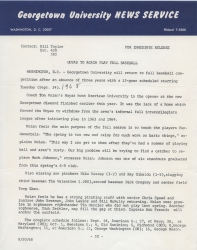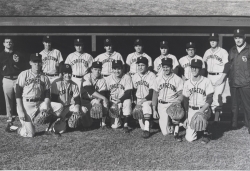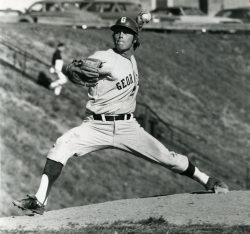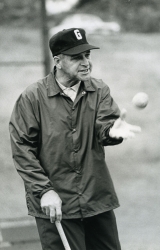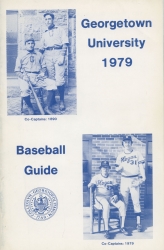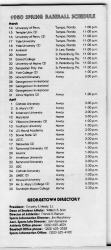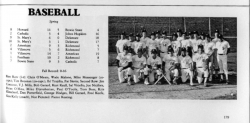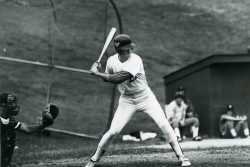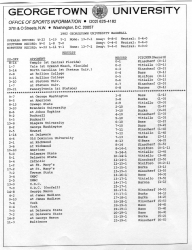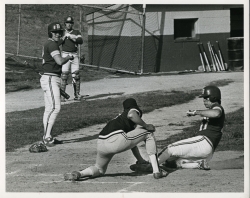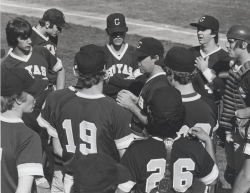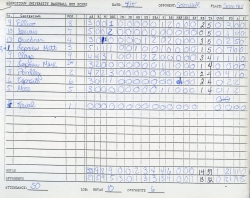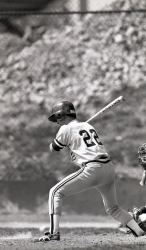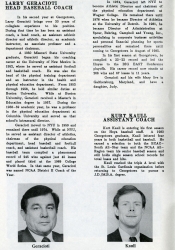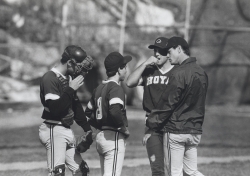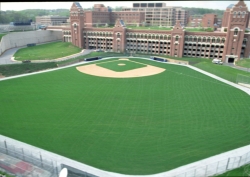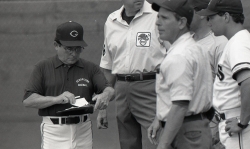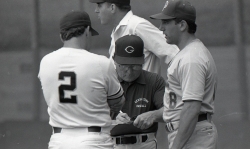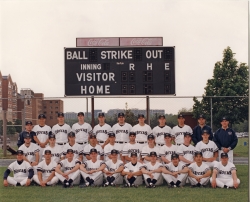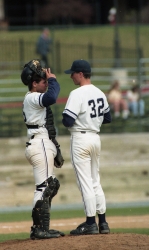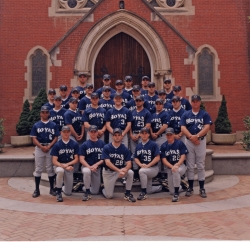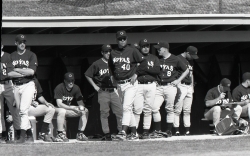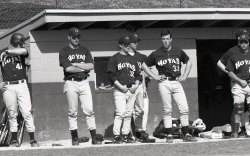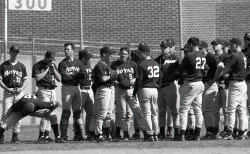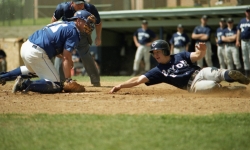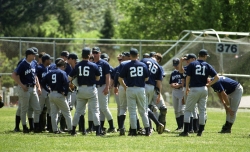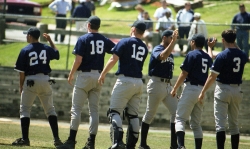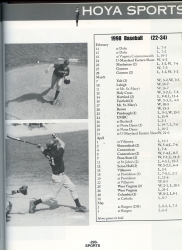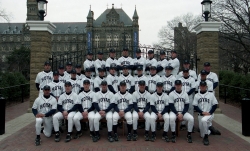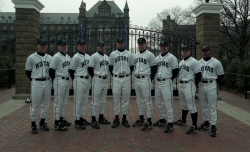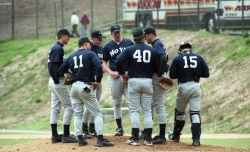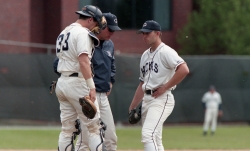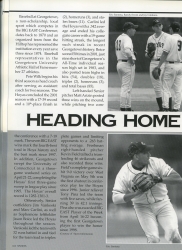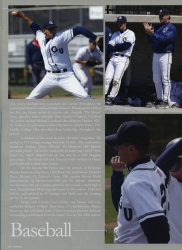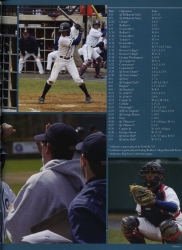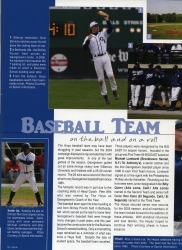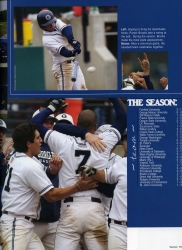Baseball is Georgetown’s oldest intercollegiate sport; the first intercollegiate game was played in 1866 against Columbian College (now known as George Washington University). By the turn of the 20th century, Georgetown was considered to be one of the most elite baseball programs in the country. As with football, the University of Virginia was Georgetown’s biggest baseball rival at this time and the two schools competed annually for dominance in the southern region. Dozens of Georgetown players went on to Major League careers; the most successful of these was probably Guy Harris White, D'1902, who went on to play for the Chicago White Stockings.
This exhibition presents a selection of photographs and documents from the Georgetown University Archives; many more baseball- related items are available to researchers who visit in person. And these items can be supplemented by examining coverage in Georgetown’s student newspapers (the Georgetown College Journal which begins in 1872 and The Hoya which begins in 1920) and yearbooks. These can be browsed and searched via the University Publications section of DigitalGeorgetown. Researchers should note that not all decades of The Hoya have been digitized; hard copies for those which have not are available in the Archives.
Mention of baseball game in the Jesuit Community’s House Diary, October 22, 1866
. . . Boys had holiday in the evening to go to a base-ball match . . .
Page from the earliest baseball score book found in the University Archives
This page documents a game played by the Stonewall Base Ball Club of Georgetown College on October 26, 1869. The complete scorebook can be accessed here via DigitalGeorgetown.
Descriptions of baseball games played in May and June 1889. From the Georgetown College Journal, July 1889
Covered are two games played by the College team against D.C. teams, the Alerts and the Wilmots, and one game played against Episcopal High School in Alexandria, Virginia. Also described are games played by the College Reserves team against the Hoys, “a strong amateur club of Georgetown,” the Emmerson Institute, and the Jeffersons.
Descriptions of baseball games played in April 1891. From the Georgetown College Journal, April 1891
Covered are games played by the College team against Dupont, the Washington Light Infantry, Lafayette College, and the YMCA.
Game schedule and description of the Georgetown College baseball team. From the Georgetown College Journal, March 1892
Descriptions of baseball games played in April 1894. From the Georgetown College Journal, April 1894
Covered are games played by the College team against Columbia, Princeton, and Yale.
Descriptions of baseball games played in March and April 1896. From the Georgetown College Journal, May 1896
Covered are games played by the College team against Gallaudet and Yale Law School.
Descriptions of baseball games played in March and April 1897. From the Georgetown College Journal, April 1897
Covered are games played by the College team against Johns Hopkins, Gallaudet, University of Vermont, Lafayette, Lehigh, Yale, and Princeton.
Georgetown’s Prep baseball team pictured in 1898
That this is a Prep team is indicated by the letter “P” which appears on caps and shirts, as well as the age of the students.
Georgetown’s baseball team pictured in 1899
Note the sign reading Champions ’99. The 1899 team won 18 out of 20 games it played against college opponents. When the season ended, they were acclaimed the intercollegiate national champions. On their return from the final game of the season, they were met at the train station by students and alumni and escorted back to campus for a bonfire-lit celebration and fireworks.
Georgetown University Yells and Songs, compliments of the Base Ball Association, circa 1900
On page three, there is a song which begins I Love nobody but you, White and is set to the air of a popular song written by Lew Sully in 1898 called I love Nobody But You, Babe. The “White” mentioned in the Georgetown version is Guy Harris White. White, known as “Doc” because he earned a DDS degree from Georgetown’s Dental School in 1902, was a standout pitcher and fielder on Georgetown’s baseball team as a student and went on to play professional baseball for the Chicago White Stockings. His greatest legacy was a major league record for most consecutive shutouts (five) was unmatched until 1968 when Dodgers pitcher Don Drysdale also pitched five consecutive shutouts.
Cover of program for Georgetown versus Gallaudet baseball game, March 30, 1901
The cover illustration is signed by John E. Sheridan, who was a Georgetown student at the time the program was created. His illustrations can be found on programs and posters for a variety of sporting events, as well as in the Georgetown yearbook and student newspaper. He went on to have a long career as an illustrator and worked for The Saturday Evening Post, Collier's Weekly and Ladies' Home Journal, among other publications.
Georgetown’s baseball team pictured in 1903
Pictured in the center of this photograph is team captain Samuel H. Apperious. Details of his refusal to play in games against Harvard in 1903 and 1904 because Harvard’s shortstop was African American can be found in this blog post.
Georgetown’s baseball team pictured in 1905
The team is posed in front of the grandstand at the northeast corner of the College Field.
Ryan Hall with the Prep athletic field seen to the right, pictured in 1905
Ryan Hall is newly completed in this photograph. The Prep Field (now the site of Lauinger Library) was used for a variety of sports, including baseball.
Georgetown-Keio University (Japan) baseball game played on the College Field, 1911
Note the Japanese flags flying on the grandstand.
Descriptions of baseball games played in May 1911. From the Georgetown College Journal, June 1911
Covered are games played by the College team against Gallaudet, Naval Academy, Catholic University, and Keio University, Japan.
Georgetown baseball-themed Murad tobacco silks, ca. 1906
American tobacco companies began including fabric swatches in their packaging as promotional items between 1906 and 1910. Although these swatches were most commonly satin, they came to be known as tobacco or cigarette “silks.” Companies encouraged women to fashion them into household items such as quilts or pillows—in fact, the inclusion of silks may have been a marketing strategy to encourage women to smoke. The silks on display form part of a set depicting idealized Georgetown athletes.
Gift of Eric Wind (F’2009)
Descriptions of baseball games played against Penn State and the Marines. From The Hoya, May 2, 1947
Also includes profile of third baseman Art Schult.
Report of Receipts and Disbursements from the Georgetown-American University baseball game, April 18, 1950
“Hoyas After Tourney Berth.” The Washington Post, May 12, 1950
Georgetown University is shooting for a berth in next month’s N.C.A.A. baseball tournament with an incredible .323 team batting average, and a sure-fire big league pitching prospect in Frank Mattingly . . .
“Hoyas to Again Play Baseball.” Georgetown University News Service, September 20, 1968
. . . Georgetown University will return to baseball competition after an absence of three years with a 13-game scheduled [sic] starting Tuesday (Sept. 24) . . .
Georgetown Head baseball coach Tommy Nolan pictured in 1970
Tommy Nolan became the head baseball coach in 1959. He retired in 1978.
Profiles of Head Baseball Coach Larry Geracioto and Assistant Coach Kurt Kaull in the 1987 Georgetown baseball media guide
Georgetown baseball field pictured in 1991
This field was located south of the Leavey Center. In 2000, baseball moved off-campus to the Shirley Povich Field at Cabin John Park in Rockville, Maryland. That field is named for famed DC sports columnist and reporter Shirley Povich who attended Georgetown Law School in the 1920s. He began working at The Washington Post while a student, beginning a seven-decade career with the publication.
Georgetown baseball team pictured in 1994
Four team members are photographed in the Quadrangle, standing in front of Dahlgren Chapel.
Georgetown baseball team pictured in 1996
Team members are photographed in the Quadrangle, in front of Dahlgren Chapel.
Curated by Lynn Conway, University Archivist

